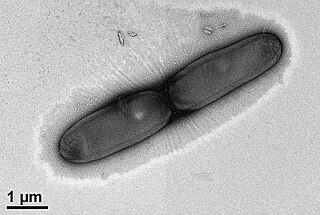Related Research Articles
Micropruina glycogenica is a Gram-positive and non-spore-forming bacterium which has been isolated from activated sludge in Japan.
Pseudonocardia spinosispora is a bacterium from the genus of Pseudonocardia which has been isolated from soil from a gold mine in Kongju on Korea.
Comamonas piscis is a Gram-negative, obligately aerobic and non-motile bacterium from the genus Comamonas which has been isolated from the intestine of the fish Sebastes schlegelii.
Asanoa ishikariensis is a bacterium from the genus Asanoa which has been isolated from soil in Japan.
Clostridium herbivorans is a Gram-positive, cellulolytic and motile bacterium from the genus Clostridium which has been isolated from the intestinal tract of pigs.
Shuttleworthia is a Gram-positive, non-spore-forming, obligately anaerobic and non-motile bacterial genus from the family of Lachnospiraceae with one known species. Shuttleworthia satelles has been isolated from the human periodontal pocket.
Mogibacterium diversum is a Gram-positive, anaerobic, rod-shaped and non-spore-forming bacterium from the genus of Mogibacterium which has been isolated from the human mouth.
Geodermatophilus africanus is a Gram-positive, aerobic and halotolerant bacterium from the genus Geodermatophilus which has been isolated from desert sand near Ourba in the Sahara.
Ileibacterium valens is a Gram-positive bacterium from the genus of Ileibacterium which has been isolated from the intestine of a murine from New York City in the United States.
Dyella jejuensis is a Gram-negative, aerobic, rod-shaped and motile bacterium from the genus of Dyella which has been isolated from soil from the Hallasan Mountain on Jeju Island in Korea.
Fulvimonas soli is a motile bacterium from the genus of Fulvimonas which has been isolated from soil from Ghent in Belgium.
Aliiroseovarius halocynthiae is a Gram-negative and motile bacterium from the genus of Aliiroseovarius which has been isolated from the sea squirt Halocynthia roretzi from the South Sea in Korea.
Aliiroseovarius sediminilitoris is a Gram-negative and motile bacterium from the genus of Aliiroseovarius which has been isolated from sediments from the South Sea from Geoje island in Korea.
Lutimaribacter saemankumensis is a Gram-negative, rod-shaped and non-motile bacterium from the genus of Lutimaribacter which has been isolated from tidal flat sediments from the Yellow Sea from Korea.
Endozoicomonas atrinae is a Gram-negative, rod-shaped, aerobic and non-motile bacterium from the genus of Endozoicomonas which has been isolated from the intestinal tract of the mollusk Atrina pectinata from Yeosu in Korea.
Anaerophaga is a Gram-positive and strictly anaerobic genus of bacteria from the family of Marinilabiliaceae with one known species. Anaerophaga thermohalophila has been isolated from anoxic sludge from Hannover in Germany.

Castellaniella fermenti is a Gram-negative and aerobic bacterium from the genus Castellaniella which has been isolated from fermented food from Taiwan.
Citricoccus muralis is a Gram-positive and aerobic bacterium from the genus Citricoccus which has been isolated from a wall painting from Sankt Georgen ob Judenburg, Austria.
Rheinheimera baltica is a bacterium from the genus of Rheinheimera which has been isolated from water from the Baltic Sea.
Dubosiella is a Gram-positive genus from the family of Erysipelotrichidae with one known species. Dubosiella newyorkensis has been isolated from the intestinal content of a murine from New York City in the United States. Dubosiella is named after the American microbiologist René Dubos.
References
- 1 2 3 4 Parte, A.C. "Isobaculum". LPSN .
- ↑ "Isobaculum". www.uniprot.org.
- ↑ Parker, Charles Thomas; Wigley, Sarah; Garrity, George M (1 January 2003). Parker, Charles Thomas; Garrity, George M (eds.). "Taxonomic Abstract for the genera". The NamesforLife Abstracts. doi:10.1601/tx.5514 (inactive 2024-04-17).
{{cite journal}}: CS1 maint: DOI inactive as of April 2024 (link) - 1 2 Collins, MD; Hutson, RA; Foster, G; Falsen, E; Weiss, N (January 2002). "Isobaculum melis gen. nov., sp. nov., a Carnobacterium-like organism isolated from the intestine of a badger". International Journal of Systematic and Evolutionary Microbiology. 52 (Pt 1): 207–10. doi: 10.1099/00207713-52-1-207 . PMID 11837304.
- ↑ "Details: DSM-13760". www.dsmz.de.